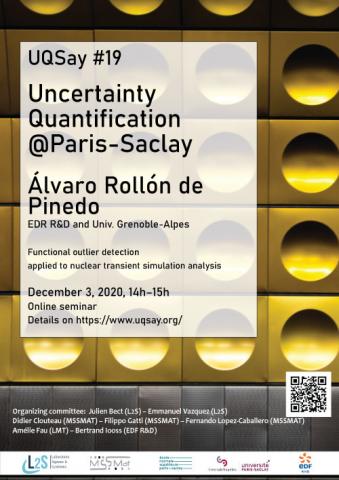
UQSay seminar #19: Functional outlier detection
The ever increasing recording and storing capabilities of industrial systems provide a large amount of physical data that can be exploited by engineers. These data may take the form of functions, usually a one-dimensional function of time, but eventually as a multidimensional function of space and time. Finding the subsets of objects that behave abnormally in them is a goal that can prove to be useful in order to avoid spurious results, simulations that do not reproduce certain physical phenomena as expected, or extreme physical events and domains. In the context of nuclear transient simulations, safety reports mostly focus on the study of some scalar parameters (safety criteria), supposed to guarantee the safety of an installation during an accidental transient as long as they do not surpass a previously established threshold. Nevertheless, the state- of-the-art simulations codes (called Best Estimate) provide a much richer and complex information, which can be better taken advantage of through the identification outlying simulations amongst those generated as outputs.
The goal of this talk is to introduce the functional outlier detection domain, highlighting its interest in industrial settings, as well as to present our detection technique and the conclusions on the physical analysis of nuclear transients that can be obtained from its use.
Joint work with Mathieu Couplet, Bertrand Iooss, Nathalie Marie, Amandine Marrel, Elsa Merle and Roman Sueur.
4, avenue des sciences Gif-sur-YvetteThe ever increasing recording and storing capabilities of industrial systems provide a large amount of physical data that can be exploited by engineers. These data may take the form of functions, usually a one-dimensional function of time, but eventually as a multidimensional function of space and time. Finding the subsets of objects that behave abnormally in them is a goal that can prove to be useful in order to avoid spurious results, simulations that do not reproduce certain physical phenomena as expected, or extreme physical events and domains. In the context of nuclear transient simulations, safety reports mostly focus on the study of some scalar parameters (safety criteria), supposed to guarantee the safety of an installation during an accidental transient as long as they do not surpass a previously established threshold. Nevertheless, the state- of-the-art simulations codes (called Best Estimate) provide a much richer and complex information, which can be better taken advantage of through the identification outlying simulations amongst those generated as outputs.
The goal of this talk is to introduce the functional outlier detection domain, highlighting its interest in industrial settings, as well as to present our detection technique and the conclusions on the physical analysis of nuclear transients that can be obtained from its use.
Joint work with Mathieu Couplet, Bertrand Iooss, Nathalie Marie, Amandine Marrel, Elsa Merle and Roman Sueur.
